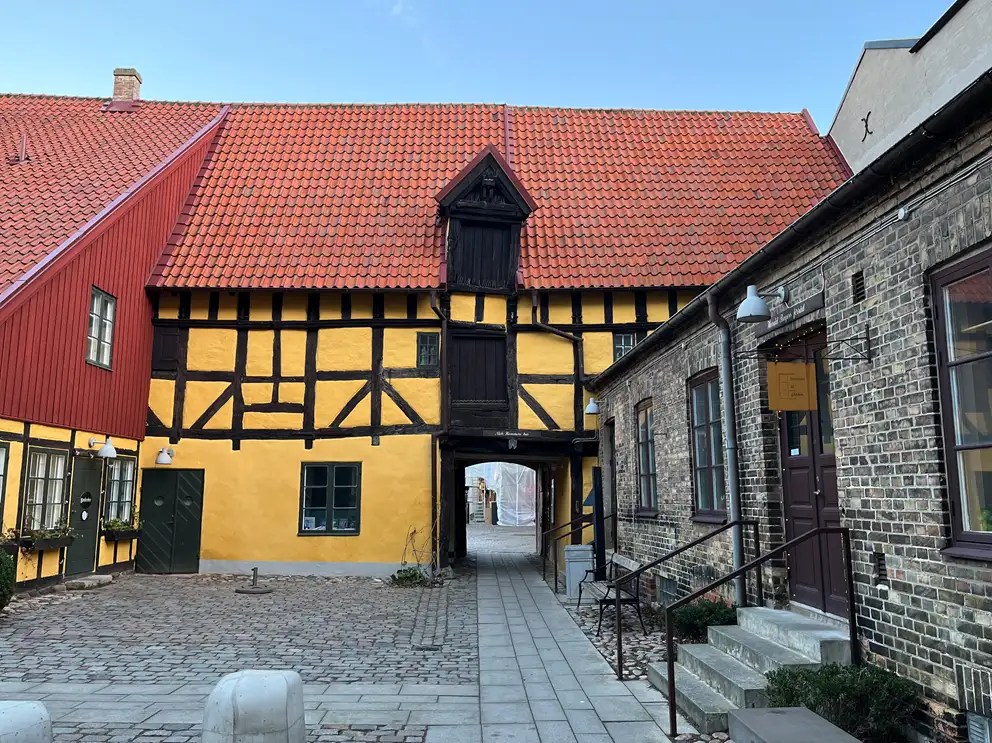The history of a transformed building
The complex of Hedmanska Gården, where Form Design Center is located, consists of five different buildings - the oldest from 1597 and newer additions from the early 17th century and 1850’s. The buildings are named after a previous owner, Gabriel Hedman, who in 1850-52 built the former grain storage wherein Form Design Center has its everyday activities today.
All the buildings are typical examples of how old city farms used to look like in Malmö, and because of the variation in age, they symbolise how this typology developed over time. Especially noticeable is the half-timbering, which has been a tradition in both Skåne (southern part of Sweden) and Denmark since the middle ages, and the use of red and yellow bricks that was an important local material. The oldest building faces the Lilla Torg (city square) with entrance to the courtyard and was build by the former mayor of Malmö, Niels Hammar. In the exterior, it is regarded as the best-preserved half-timbering building from the end of the 16th century.
Renovations – working with a protected building
The inner organisation of Form Design Center is distributed on four floors. The café and shop are located at the entrance on street level, and on the 2nd floor is the exhibition space where the current “Cathedral Thinking” exhibition highlights the theme ‘transformation of churches’ in Sweden.
Before it became the home of Form Design Center in 1974, the building, owned by Malmö Stad, Stadfastigheter, stood empty for 10 years.
In 1993, Hedmanska Gården was declared worthy of preservation, and the building mass is protected, which means that form Design Center has to be creative when inhabiting the rooms. One example of how this is solved is the added interior walls between the window openings – on these it is possible to hang pictures and other parts of an exhibition that are not allowed on the original brick walls.
 What has been done since Form Design center moved in?
What has been done since Form Design center moved in?
The building underwent renovation in the early 1970’s when Form Design Center first moved in. This included the substitution of roof tiles, which were replaced with reused tiles from the then recently demolished Lugnet area in Malmö.
In 2014 Stadsfastigheten applied for permission to restore roofs and facades of Hedmanska Gården. The roof tiles, battens and the underlying roof-felt was considered to be in bad condition, and it was necessary to straighten the roof panels and ridges.
After further inspection, the underlying roof-felt was in much better condition than expected proving that the old tiles still had the ability to divert water in an efficient manner. Tiles on all buildings were taken down to be sorted after condition, cleaned and reused to the extent possible. All ridge tiles where replaced with new ones as well as rot-damaged roof panels, and all battens and underlying roof-felt was renewed.
In the old building complex there were many different metal types, and it has not been clarified which one is the original. It was decided early in the process that factory painted aluminium should be avoided, since this material is foreign to many older buildings. Sheet metal work on the roof as well as gutters and pipes are now made in lacquered aluminium sheet except for the facades facing Lilla Torg where all metal work was replaced with detailing in cobber.
Joinery details on windows, doors and gates were renovated by puttying the windows with linseed oil and brush painting the wood with linseed oil paint that gives the surface life and reflects the light. The old skylights in tin and cast iron were cleaned and painted as well.
All colours were taken based on the original colour palette.
Regarding the building where Form Design Center is based, all roof tiles are new, and the old ones are reused on other parts of the complex. Reparations of the exterior cornice have been necessary too. The new roof consists of a mixture of used red Veberöd DH-tiles and new Vittinge ridge tiles. The cleaned and reused skylight-windows are sealed with lime mortar where the window edge meets the roof tiles.
As part of Form Design Center’s anniversary, the look of the old granary was furthermore given a makeover by Wingårdhs Arkitekter intending to make the façade more open and inviting to people coming from the street.